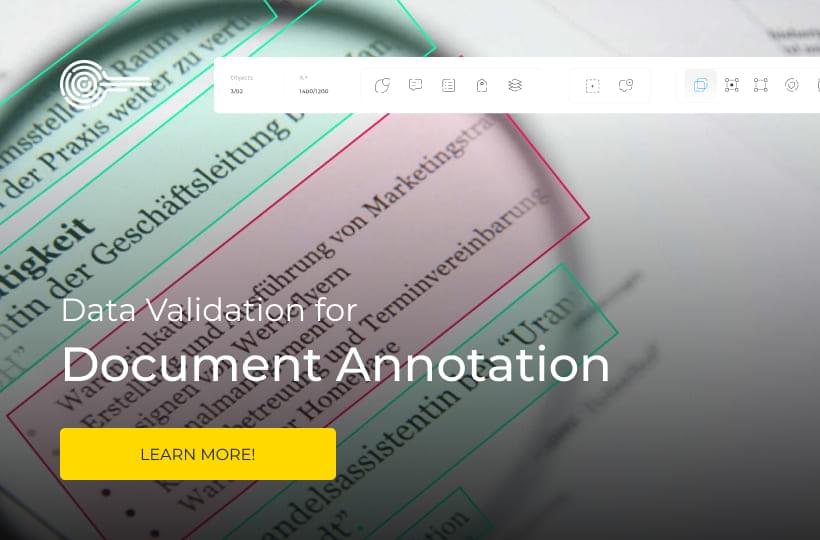Named Entity Recognition: Best Practices for Text Annotation
As information volumes develop, precisely perceiving and marking elements like people, associations, and areas becomes more fundamental. Implementing NER labeling effectively is essential for improving AI-driven applications, from sentiment analysis to automated data entry.
NER converts unstructured text into structured, usable data. We will inspect how NER labeling can change text explanations and drive computer-based intelligence progressions.
Key Takeaways
- Named Entity Recognition (NER) significantly enhances the efficiency of document processing and payment systems by up to 60%.
- Adequate NER labeling is essential for accurate sentiment analysis, customer service automation, and AI-driven applications.
- Understanding different types of named entities and their categories can improve data annotation quality.
- Utilizing machine learning and deep learning methods ensures higher accuracy in NER tasks.
- Adopting best practices in NER annotation boosts NLP models' overall performance and reliability.
- NER tagging converts unstructured data into valuable, structured information, providing a competitive edge in data-driven decision-making.
- Choosing the right tools and frameworks is critical for efficient and accurate NER implementation.

What is Named Entity Recognition?
Named Entity Recognition (NER) recognizes and sorts elements in unstructured text. These substances incorporate names of individuals, associations, areas, dates, and other essential terms. NER frameworks examine messages to pinpoint these elements, involving sentence limits for setting. They classify elements in light of their tendency and setting, similar to "Apple," alluding to the natural product of the tech organization.
Importance of NER in Natural Language Processing
NER is fundamental in addressing questions, data recovery, and machine interpretation. It structures unstructured data, assisting the precision of endeavors with preferring linguistic structure naming and parsing. Despite hardships like dubiousness altogether, NER's effect crosses various regions:
- In recruitment, only 25% of resumes are manually reviewed, with the rest filtered by automated systems using NER.
- In healthcare, NER models accurately identify symptoms, diseases, and chemicals in electronic health records, aiding in patient diagnosis.
NER systems can classify documents into types and adapt to specific document characteristics. Implementing NER involves lexicon-based, rule-based, machine-based, and deep learning-based methods. Deep learning NER systems excel because they understand semantic and syntactic word relationships.
Using Python for NER can leverage spaCy for text processing and named entity extraction. Tools like Stanford NER offer robust feature extractors and support for multiple languages.
Types of Named Entities
- Person: Names of individuals, including authors, speakers, and fictional characters.
- Location: Geographical places like cities, countries, and natural landmarks.
- Organization: Names of companies, institutions, agencies, and other entities.
- Miscellaneous: Other specific entities, including dates, times, monetary values, and nationalities.
The Named Entity Recognition Process
Named Entity Recognition (NER) is a step-by-step process for recognizing and classifying elements in text. It includes several stages, from information preprocessing to utilizing progressed instruments and AI. Each step is essential for accomplishing high exactness in substance extraction and labeling.
Data Preprocessing Techniques
Effective NER begins with thorough data preprocessing. Key techniques include:
- Tokenization: Breaking down text into individual tokens.
- Part-of-speech tagging: Assigning parts of speech to each token.
- Chunking: Grouping tokens into meaningful chunks.
These means make the substance extraction and labeling process more effective. They guarantee that the resulting steps are more precise and effective.
The Role of Machine Learning in NER
AI, and deep learning, specifically, is fundamental in NER:
- Transfer learning: Leveraging pre-trained models like BERT and GPT to improve entity recognition.
- Active learning: Integrating models to suggest entities saves time during annotation.
Deep learning frameworks for NER have shown accomplishment across different areas. They limit the requirement to include designing. Early NER frameworks were rule-based. However, the shift towards AI models around 2007 checked critical headways. Today, dynamic, semi-regulated, and unaided learning methods offer similar outcomes to deep learning models. These progressions highlight the basic job of AI in element extraction and labeling.
Guidelines for Accurate Labeling
Accurate labeling requires entities to be labeled consistently across all documents. Each entity type, like "Person" or "Location," should be tagged uniformly. Training models with about 50 labeled instances per entity type enhance performance. Standard annotation schemes like IOB and BIOES tagging facilitate clear and consistent labeling.
Common Mistakes to Avoid
Normal mistakes can affect results in named substance classification. Conflicting naming, where a similar substance type is labeled in an unexpected way, is a successive mix-up. Mislabeling because of setting oversight likewise diminishes dataset quality. Carrying out thorough surveys and clear rules can assist with avoiding these blunders.
Criteria for Choosing an Annotation Tool
The viability of NER labeling intensely relies upon the explanation instrument picked. A few rules ought to be thought about while choosing an explanation instrument:
- Assessability of the Interface: An instinctive and easy-to-understand connection point can accelerate explanation. It makes it simpler for annotators to zero in on the job that needs to be done.
- Integration Capabilities: The device ought to flawlessly integrate with other programming and libraries, which is currently a part of the NER project work process.
- Scalability: It should help adaptability oblige enormous datasets and complex element structures without compromising execution.
- Collaboration Support: The device should work with cooperative explanations for projects, including various annotators. It ought to have highlights, such as job-based admittance and adaptation control.
Choosing an annotation tool depends heavily on the specific project requirements and the entities' complexity.

Collaborating with Domain Experts
Adequate text substance explanation vigorously depends on space specialists' feedback. They bring significant knowledge into explicit element types that ordinary annotators could miss. Their aptitude adjusts the comment task with certifiable applications, further developing NER model execution.
Domain specialists can aid:
- Validating annotations: Guaranteeing they satisfy industry guidelines.
- Providing context: Giving a more deep comprehension of every substance's pertinence.
- Training annotators: Sharing prescribed procedures and regular traps to stay away from.
It is precise and significant to Team up with specialists to guarantee comments. This upgrades the nature of AI models.
Executing these systems will improve our capacity to make excellent message element comments, which is essential for NER applications in medical services, money, and client care.
Techniques for Quality Control
A few strategies are utilized for quality control in NER projects. One key technique is a twofold explanation. Here, two annotators mark the equivalent dataset freely. Inconsistencies are then settled through settlement.
Ordinary reviews are likewise fundamental to the NER information naming interaction. They help distinguish and address repeating mistakes. Refining rules given review results keeps NER frameworks exact and current. AI instruments can semi-mechanize these checks, working on speed and accuracy.
Building a custom NER model with spaCy requires exact advances, which require thorough quality control to create dependable outcomes.
Applications of NER in Industry
Immense measures of information, fundamentally unstructured, are produced consistently. NER is fundamental for arranging this information.
Monetary experts use element extraction and labeling to:
- Screen web-based entertainment patterns to follow brand feeling
- Remove applicable information from stages like Twitter and Reddit
- Make organized data sets from unstructured profit reports by connecting organization names to content information bases
- Improve search calculations by labeling records, coming about in a quicker look
Success Stories of NER Implementations
Organizations like Google and Amazon feature NER's extraordinary effect. Their frameworks computerize processes, giving them an upper hand.
Google involves NER for its pursuit calculations, labeling archives with extricated elements. This velocities up search execution and further develops pertinence. It's vital to research's prosperity, guaranteeing clients come by speedy and exact outcomes.
Amazon utilizes NER to improve its proposal calculations. By removing substances, Amazon suggests comparative items or content, enhancing the client experience and helping deals.
In finance, experts use NER for industry and deep examinations. Record labeling further develops research productivity, permitting examiners to zero in on high-esteem assignments and convey ideal knowledge.
Summary
As we finish up our conversation on Named Entity Recognition (NER), it's imperative to note the advancing patterns forming its future. Progresses in artificial intelligence and AI are driving the improvement of further developed NER frameworks. These developments tackle difficulties like preparation on small datasets and overseeing low-asset settings.
A functional comment is critical to fruitful NER executions. Accomplishing excellently named substance acknowledgment marking requires an exact and reliable explanation of the message element. Our past conversations framed an itemized procedure for precise and predictable comments. Future headways will be planned to limit human predisposition and blunder.
Embracing these advancements and zeroing in on consistency and quality will keep NER frameworks successful as we progress. They will be fundamental for different applications, from data extraction to menial helpers.
FAQ
What is Named Entity Recognition (NER) in Natural Language Processing?
Named Entity Recognition (NER) is a key process in natural language processing (NLP). It identifies and categorizes essential elements in the text. These include names of people, organizations, and locations in specific categories.
Why is NER important in NLP?
NER is vital in NLP for organizing unstructured data. It enables effective information processing and analysis, which supports advanced applications like machine translation and intelligent chatbots. It also improves customer experiences and operational efficiency.
What are the types of named entities typically identified in NER?
Named entities are categorized into several types. These include person names, locations, organizations, and miscellaneous entities. The latter can consist of dates, times, and nationalities.
How does NER differ from other NLP tasks?
NER focuses on identifying and extracting noun phrases. It classifies them into specific labels. This helps machines accurately understand and categorize real-world entities.
What are some data preprocessing techniques used in NER?
Data preprocessing in NER involves several techniques. These include tokenization, part-of-speech tagging, and chunking. They prepare the text for effective entity recognition and labeling.
Which tools and libraries are commonly used for NER?
Popular NER tools include SpaCy, NLTK, and BERT. These tools offer robust functionalities for entity recognition and labeling tasks in NLP.
What role does machine learning play in NER?
Machine learning, and deep learning, in particular, is essential for NER. It automates and enhances the accuracy of NER processes. Models like BERT and GPT have set new benchmarks in understanding human language.
What are the best practices for accurate NER labeling?
Understanding entity types is key to accurate NER labeling. Adhering to specific guidelines and conducting regular reviews is also essential. This ensures high data quality and consistency.
What are some common mistakes to avoid when labeling NER?
Common mistakes include inconsistent labeling and overlooking context. Clear guidelines and regular reviews can help avoid these. They ensure consistency and accuracy in labeling.
What are the key criteria for choosing an annotation tool for NER?
When choosing an annotation tool, consider usability, integration, scalability, and support for collaborative annotation. The choice depends on project requirements and entity complexity.
How can collaboration with domain experts enhance NER annotation strategies?
Collaboration with domain experts ensures annotation strategies align with real-world applications. They provide insights into nuanced entity types, improving the quality and relevance of annotated data.
What quality control techniques are used in NER projects?
Quality control in NER projects includes double-annotation and adjudication to resolve discrepancies. Regular audits are also used. AI tools for semi-automated quality checks can enhance efficiency and accuracy.
Can you provide examples of successful NER implementations in the industry?
Companies like Google and Amazon have successfully implemented NER systems. These systems automate and enhance operations. NER finance, healthcare, and media applications show significant competitive advantages and improved efficiency.
What trends are shaping the future of NER?
Trends in NER include the increasing use of unsupervised learning methods. This reduces dependency on annotated data. Ongoing AI and machine learning advancements will accurately handle more complex and voluminous data.
